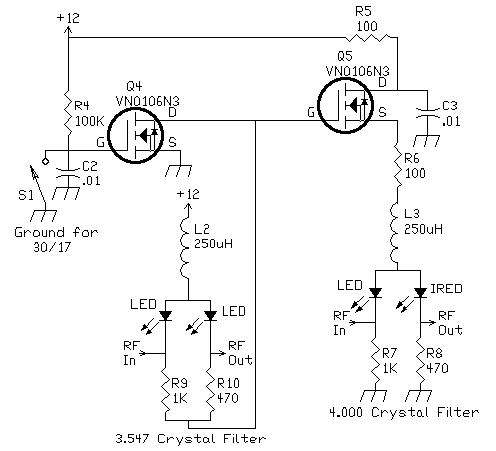|
When the SPST switch (S1) is open, Q4 is on and is grounding the LEDs at the input of the 3.547 MHz crystal filter. 12 Volts goes through a 250uH choke, an LED (& 1K current limiting resistor), an IRED, (& 470 ohm current limiting resistor) and through Q4 to ground.
Also, when Q4 is on, the gate of Q5 is grounded, turning Q5 off.
When the SPST switch (S1) is closed, the gate of Q4 is grounded, turning off Q4. 12 Volts flows through the LEDs and brings the gate of Q5 to 12 volts, turning Q5 on.
Since the gate resistance is so high, on the order of megohms, no current flows and
the 3.547 MHz LEDs cannot turn on. Q5 is turned on, passing 12 Volts through
a 100 ohm resistor and 250uH choke, turning on the LEDs at the 4.000 MHz
crystal filter.
Control Center of Receiver
Operation of the IRED at the 4.000MHz Crystal Filter
When the Crystal Filter Switch is turned to the 4.000 position, the 4.000 IRED will turn on the phototransistor at the the crystal oscillator, changing the frequency of the oscillator to 3.547 MHz.
If the receiver is used with a DDS VFO that can only be set up with one Crystal Filter frequency, the choice with the BLT is using 3.547MHz crystals on both crystal filters, one set up for wide bandwidth and the other narrow bandwidth. With the picture above, the upper filter is wide and the lower one is narrow. This is the way the kit is set up and only 3.547MHz crystals are supplied for the filters.
The IRED is not used, for the off position of the Crystal Oscillator switch is turning on the 4.000MHz crystal, resulting in a 455kHz IF signal for the IF strip. the Phototransistor at the Crystal Oscillator is not installed, or covered up with black plastic tape to prevent it from turning on.
If the DDS VFO on Board 1 is used, it can be programmed for two crystal filters, in which case the upper filter will be 3.547MHz and the lower one 4.000MHz. If the 3.547 MHz fitter is being used, with no IR light on the Phototransistor at the Crystal Oscillator, the crystal oscillator is switched to the 4.000MHz crystal, giving 455kHz out of the 2nd mixer. When the 4.000MHz filter is chosen, the IR light turns on, the Phototransistor is turned on, switching the Crystal Oscillator to 3.547MHz, giving the 455kHz output at the 2nd mixer.
Replacing the SPST Crystal Switch with IR Switching
The phototransistor needs to be bent over, facing the front of the receiver. The phototransistor is shown straight up for clarity in showing how it is mounted.
The image shows the correct installation of the phototransistor at the Crystal Filter Switch.
The crystal filter switch is 6" to 7" from the front of the PCB, and may need more IR from the emitter, or an increase in the sensitivity of the IR receiver.
For maximum output of the IRED (50MA), use a 270 ohm, 1 watt resistor.
If the distance is going to be more than 6", best reliability will result with a 470K sensitivity resistor, and use a black tube to cover the IR path.
If covering the IR path is not done, raise the output of the IRED to it's maximum with a 270 ohm resistor.
|





